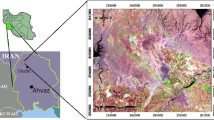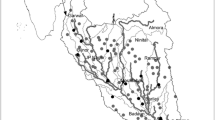Abstract
In approaching the task of developing recharge estimates for dam sites, several constraints are apparent, including the scarcity of site-specific data for the selected new sites and the availability of simple yet robust analysis techniques. Combined, these constraints require an approach which involves best use of available data, adoption of relatively simple analytical approximations of reality, and the adoption of several key assumptions. In arid country with limited resources, two simple techniques have been used for recharge estimation: (1) a simple water balance model in spreadsheet and (2) a more refined Darcian approach involving an analytical approximation of a flow-net solution. By applying the two models at three new dam sites, the amount of recharge rates calculated over the period 2007–2026 was close. This is because, despite Darcian approach that should have affected the recharge rate as other parameters were introduced in the calculation of q t , e.g., groundwater table mound, reservoir water height, etc., the results show general agreement between the two methods which seem to validate the assumptions made in both methods. A general conclusion of this comparison is that the hydraulic conductivity (K) is the main determining factor in recharge calculations in these situations. The water balance model was used to estimate recharge at Wadi Bahaman, under gravity and cascade dams’ scenarios. Using gravity dam at Wadi Bahaman for groundwater recharge proved not suitable based on the relatively small predicted runoff from a small catchment area and geological concerns in the abutment areas. Instead, a series of three low check dams (2 to 4 m high) was proposed. These check dams will slow down the runoff flow, form small reservoirs, and enhance recharge along the valley, without requiring expensive foundations. Estimated groundwater recharge under cascade dams (141,407 m3/year) is greater than recharge estimated for gravity dam (103,853 m3/year) by at least 36%.
ملخص
عند إجراء تقديرات لقيم التغذية الجوفية عند مواقع سدود ، تظهر العديد من القيود مثل : ندرة معلومات الموقع الجديد التى سيقام فيه السد ، وتوفر تقنيه بسيطة ومتينة للتحليل. هذه القيود تحتم إيجاد تقنية قادرة على الاستخدام الأفضل للمعلومات المتوفرة وتتبنى أسهل الطرق التحليلية لتقريب الواقع وتتبنى عدة فرضيات رئيسية. في بلد قاحل وفقير ، تم استخدام تقنيتان بسيطتان لتقدير التغذية الجوفية هما: 1) نموذج مبسط للميزان المائي من خلال الجدولة فى الحاسب 2) حل تقريبي معدل لمعادلة دارسي لتدفق المياه.
بتطبيق النموذجين على ثلاث مواقع مقترحه لأنشأ سدود جديدة ، وجد ان قيمة التغذية الجوفية المستحثاة من السدود للفترة ما بين 2007–2026 متقاربين. هذا بالرغم من إن طريقة دارسي شملت إدخال العديد من المعاملات في حساب معدل التغذية الجوفية مثل: منسوب المياه الجوفية تحت السد ، ارتفاع المياه في بحيرة السد ..الخ. موافقة النتائج للنموذجين يعنى صلاحية الفرضيات التي استخدمت في الطريقتين. كما استنتج من هذه المقارنة بان العامل الرئيسي في حساب التغذية الجوفية لمثل هذه الحالات هو قيمة التوصيل الهيدروليكي.
تم استخدام نموذج الميزان المائي لحساب التغذية في وادي بهمان تحت سيناريوهين: سد كبير (جاذبية) وسدود صغيرة (حواجز). وجد عدم مناسبة انشأ سد كبير في وادي بهمان لتغذية المياه الجوفية لقلة الجريان السطحي بسبب صغر مساحة متجمع المياه (المصيدة) ، ولمخاوف جيولوجية للمناطق الداعمة للسد. لذا تم اقتراح استخدام سلسلة من ثلاث سدود ذات ارتفاع منخفض (2–4 متر). وجد إن سلسلة السدود الصغيرة سوف تبطئ تدفق الجريان السطحي ، تشكل بحيرات صغيرة وستحسن التغذية الجوفية الصناعية دون الاحتياج للمنشات الغالية. قدرت التغذية الجوفية تحت السدود الصغيرة ب 141,407 متر مكعب سنويا وهى أكثر بحوالي 36% من التغذية الجوفية المستحثاه من السد الكبير (الجاذبية) و الذي قدرت تغذيته الجوفية المستحثات ب 103,853 متر مكعب سنويا.





Similar content being viewed by others
References
Abdul Razzak MJ, Sorman AU, Alhames AS (1989) Water balance approach under extreme arid condition—a case study of Tabalah basin, Saudi Arabia. Hydrol Process 3:107–122
Alderwish AM (1995) Estimation of groundwater recharge to aquifers of Sana'a Basin, Yemen. Unpublished Ph.D. thesis, UCL, University of London. UK
Alderwish AM, Dottridge J (1995) Modeling the Infiltration from Ephemeral Wadi Flows in the Sana’a Basin, Yemen. In: Younger P (ed), Modeling river aquifer interactions. British Hydrological Society, occasional paper, 6 pp 4–16
Alderwish AM, Al Eryani Ml (1999) Water right aspects of the proposed sources for Sana’a water supply, In: Fendekova M, Fendek M (eds) Hydrogeology and land use management. Slovak Association of Hydrogeologists, IAH Publications, pp 3–7
Besbes M, Delhomme JP, De Marsily G (1978) Estimating recharge from Ephemeral streams in arid regions: a case study at Kairouan, Tunisia. Water Resour Res 14:281–290
Bouwer H (1978) Groundwater hydrology, McGraw-Hill Series in Water Resources, 480 pp
Freeze RA, Cherry JA (1979) Groundwater. Prentice Hall, Englewood Cliffs, p 404
Hydosult-Komex-Darwish (2002) The supply management and aquifer recharge study on Sana’a Basin. Volume 1 Main Report. World Bank, Ministry of Planning and Development. Yemen
Linsley RK, Kohlier MA, Paulus JLH (1975) Hydrology for engineers. McGraw Hill, New York
Parissopoulos GA, Wheater HS (1995) Simulation of groundwater recharge from flash floods—the case of Wadi Tabalah, EWRA 95 Symposium on Water Resources Management in the Mediterranean under Drought or Water Shortage Conditions. In: Tsiourtis NX (ed). Balkema, Brookfield, pp 169–177
SAWAS Project (1996) Surface water assessment of Wadi Al Kharid and Wadi Surdud. Final Technical Report. TR number 9 and 10. TNO Institute of Applied Geosciences, Delft, The Netherlands and National Water and Sanitation Authority (NWSA), Sana’a, Yemen
Reeder J, Freyberg L, Franzini, Remson I (1980) Infiltration under rapidly varying surface water depths. Water Resour Res 16:97–104
TSHWC, Technical Secretariat of the High Water Council (1992) Surface Water. Final Report. vol. 3, UNDP/DESD project YEM/88/001
Wheater HS (1988) Hydrological assessment for dam design in the Muscat catchment, Consultancy Report to G. Maunsell & Ptnrs, 1988, pp 1–11
Wheater HS, Jolley TJ, Peach D (1995) A water resources simulation model for groundwater recharge studies: an application to Wadi Ghulaji, Sultanate of Oman, Int. Conf. on Water Resources Management in Arid Countries, Muscat, 1995, pp 502–510
World Bank (2001) Sana'a Basin Water Management Project (SBWMP) supply management and aquifer recharge study. RFP No 1/01. Project Preparation Team. Ministry of Planning and Development. Yemen
Acknowledgments
The author acknowledges the anonymous contributors to this work.
Author information
Authors and Affiliations
Corresponding author
Rights and permissions
About this article
Cite this article
Alderwish, A.M. Induced recharge at new dam sites—Sana’a Basin, Yemen. Arab J Geosci 3, 283–293 (2010). https://doi.org/10.1007/s12517-009-0075-8
Received:
Accepted:
Published:
Issue Date:
DOI: https://doi.org/10.1007/s12517-009-0075-8




